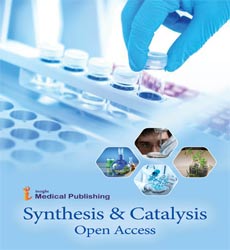ISSN : 2574-0431
Synthesis and Catalysis: Open Access
Molecular Recognition and Self-assembly as Drivers of Selectivity and Efficiency
Mester Lengerke
Department of Chemical and Biomolecular Engineering, University of Melbourne, Melbourne, Australia
*Corresponding author:
Mester Lengerke
Department of Chemical and Biomolecular Engineering, University of Melbourne, Melbourne, Australia
Email: mesterengerke@rea.au
Received: February 01, 2025, Manuscript No. ipscoa-25-20552; Editor assigned: February 03, 2025, PreQC No. ipscoa-25-20552; Reviewed: February 15, 2025, QC No. ipscoa-25-20552; Revised: February 20, 2025, QI No. ipscoa-25-20552; Published: February 28, 2025, DOI: 10.21767/2574-0431.2025.11.1.04
Citation: Lengerke M (2025) Molecular Recognition and Self-assembly as Drivers of Selectivity and Efficiency. Synth Catal Vol: 11 No: 1: 04.
Introduction
One of the most remarkable features of chemistry and biology is the ability of molecules to recognize one another and organize into ordered structures with high precision. From the exquisite binding of enzymes to their substrates, to the assembly of lipid bilayers and DNA double helices, molecular recognition and self-assembly form the foundation of life itself. These two phenomena are closely linked: molecular recognition involves the specific noncovalent interactions between molecules, while self-assembly describes the process through which molecules spontaneously organize into functional supramolecular architectures. Together, they underpin the selectivity, efficiency, and adaptability of both natural and synthetic systems. In recent decades, scientists have drawn inspiration from biology to harness these principles in nanotechnology, drug design, materials science, and green chemistry, where the demand for precise and efficient processes is greater than ever. This article explores the molecular basis of recognition and self-assembly, examines their interplay in driving selectivity and efficiency, and highlights their wide-ranging applications in advancing science and technology [1].
Description
Though weaker than covalent bonds individually, these interactions, when orchestrated collectively, confer extraordinary specificity. For example, the complementary base pairing in DNA relies on hydrogen bonds between adenineâ??thymine and guanineâ??cytosine pairs, while the stacking of aromatic bases further stabilizes the double helix. Similarly, antibodies recognize antigens through finely tuned shape and charge complementarities in their binding sites. In both cases, molecular recognition enables high fidelity processes, ensuring that complex systems operate with minimal error despite the vast diversity of potential interactions in a crowded molecular environment [2].
Self-assembly, meanwhile, provides a strategy for constructing nanostructures and functional materials. Amphiphilic block copolymers, for example, assemble into micelles, vesicles, or nanofibers, offering controlled architectures for encapsulating drugs or designing responsive materials. DNA nanotechnology exploits the predictability of base pairing to create two- and three-dimensional structures with nanometer precision. These DNA origami structures not only showcase the power of self-assembly but also demonstrate how recognition-driven assembly can be programmed for diverse functions, from molecular computing to targeted drug delivery [3].
In nanomedicine, recognition and self-assembly combine to create smart therapeutic platforms. Lipid nanoparticles, which self-assemble into stable carriers, exploit recognition motifs such as targeting ligands to deliver drugs or genetic material to specific cells. This strategy has revolutionized vaccine delivery, as demonstrated by mRNA-based COVID-19 vaccines, where lipid nanoparticles ensured stability, targeted delivery, and efficient uptake. Similarly, peptide-based nanostructures can self-assemble into fibrils or hydrogels that respond to environmental triggers, enabling controlled drug release or tissue engineering scaffolds. In these contexts, recognition imparts selectivity at the molecular interface with biological targets, while self-assembly provides the efficiency of spontaneous structure formation [4].
Beyond applications, the environmental implications of recognition and self-assembly are profound. Processes driven by noncovalent interactions often occur under mild conditions, avoiding harsh solvents, extreme temperatures, and toxic reagents. This aligns them with the principles of green chemistry, where efficiency is measured not only by yield but also by sustainability. For instance, enzyme-mimetic catalysts harness recognition to perform selective transformations in water at ambient temperatures, reducing energy consumption and waste [5].
Conclusion
Molecular recognition and self-assembly represent two of the most fundamental and powerful strategies through which nature achieves selectivity and efficiency. From the molecular recognition that ensures faithful DNA replication to the self-assembly of cellular membranes and viral capsids, these processes illustrate how noncovalent interactions can orchestrate complexity with elegance and precision. By understanding and harnessing these principles, scientists have created new avenues in drug design, catalysis, nanotechnology, and materials science, where recognition confers selectivity and assembly enhances efficiency. Their applications extend from smart therapeutics to molecular electronics, from green chemistry to adaptive materials, underscoring their universality and transformative potential.
Acknowledgement
None.
Conflict of Interest
None.
References
- Shi R, Proteau A, Villarroya M, Moukadiri I, Zhang L, et al. (2010). Structural basis for Fe-S cluster assembly and tRNA thiolation mediated by IscS protein–protein interactions. PLoS Biol 8: e1000354.
Google Scholar Cross Ref Indexed at
- Tirupati B, Vey JL, Drennan CL, Bollinger JM (2004). Kinetic and structural characterization of Slr0077/SufS, the essential cysteine desulfurase from Synechocystis sp. PCC 6803. Biochemistry 43: 12210-12219.
Google Scholar Cross Ref Indexed at
- Hayashi T, Momota M, Kuroda E, Kusakabe T, Kobari S, et al. (2018). DAMP-inducing adjuvant and PAMP adjuvants parallelly enhance protective type-2 and type-1 immune responses to influenza split vaccination. Front Immunol 9: 2619.
Google Scholar Cross Ref Indexed at
- Bezbaruah R, Chavda VP, Nongrang L, Alom S, Deka K, et al. (2022). Nanoparticle-based delivery systems for vaccines. Vaccines 10: 1946.
Google Scholar Cross Ref Indexed at
- Guerrini G, Magri D, Gioria S, Medaglini D, Calzolai, L. (2022). Characterization of nanoparticles-based vaccines for COVID-19. Nat Nanotechnol 17: 570-576.
Open Access Journals
- Aquaculture & Veterinary Science
- Chemistry & Chemical Sciences
- Clinical Sciences
- Engineering
- General Science
- Genetics & Molecular Biology
- Health Care & Nursing
- Immunology & Microbiology
- Materials Science
- Mathematics & Physics
- Medical Sciences
- Neurology & Psychiatry
- Oncology & Cancer Science
- Pharmaceutical Sciences
